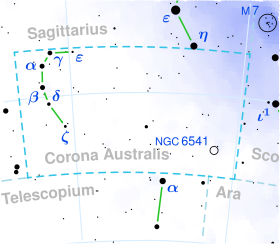Astronomy:HD 169853
| Observation data Epoch J2000.0 Equinox (celestial coordinates) | |
|---|---|
| Constellation | Corona Australis |
| Right ascension | 18h 28m 27.11405s[1] |
| Declination | −38° 59′ 44.4102″[1] |
| Apparent magnitude (V) | 5.62±0.01[2] |
| Characteristics | |
| Spectral type | A2m A2-F0[3] or A3 III[4] |
| B−V color index | +0.13[5] |
| Astrometry | |
| Radial velocity (Rv) | −21.3±1.2[6] km/s |
| Proper motion (μ) | RA: +0.096[1] mas/yr Dec.: −41.093[1] mas/yr |
| Parallax (π) | 8.3424 ± 0.0673[1] mas |
| Distance | 391 ± 3 ly (119.9 ± 1.0 pc) |
| Absolute magnitude (MV) | +0.13[7] |
| Details | |
| Mass | 2.09+0.39−0.25[8] M☉ |
| Radius | 3.72±0.12[9] R☉ |
| Luminosity | 60.7+1.0−1.1[1] L☉ |
| Surface gravity (log g) | 3.64[10] cgs |
| Temperature | 8,437±164[8] K |
| Metallicity [Fe/H] | −0.01[11] dex |
| Rotational velocity (v sin i) | 22.6±0.3[12] km/s |
| Age | 585+67−66[1] Myr |
| Other designations | |
| Database references | |
| SIMBAD | data |
HD 169853, also known as HR 6910 or rarely 9 G. Coronae Australis, is a solitary star[14] located in the southern constellation Corona Australis. It is faintly visible to the naked eye as a white-hued point of light with an apparent magnitude of 5.62.[2] Gaia DR3 parallax measurements imply a distance of 391 light years,[1] and it is currently approaching the Solar System with a heliocentric radial velocity of −21.3 km/s.[6] At its current distance, HD 169853's brightness is diminished by 0.36 magnitudes due to extinction from interstellar dust[15] and it has an absolute magnitude of +0.13.[7]
HD 169853 has a stellar classification of A2mA2-F0,[3] indicating that it is an Am star with the calcium H lines of an A2 star and the metallic lines of an F0 star. Abt and Morell (1995) give a class of A3 III,[4] indicating that the object is instead an evolved A-type giant star with no chemical peculiarities. A paper published in late 1987 found that HD 169853 had an overabundance of silicon, manganese, strontium, and barium.[16]
The object has 2.09 times the mass of the Sun[8] and a slightly enlarged radius of 3.72 R☉.[9] It radiates 60.7 times the luminosity of the Sun[1] from its photosphere at an effective temperature of 8,437 K.[8] It has a near solar metallicity at (Fe/H) = −0.01[11] and it is estimated to be 585 million years old, having completed 80% of its main sequence lifetime.[1] Like many chemically peculiar stars, HD 169853 rotates rather slowly, having a projected rotational velocity of 22.6 km/s.[12]
References
- ↑ 1.0 1.1 1.2 1.3 1.4 1.5 1.6 1.7 1.8 Vallenari, A. et al. (2022). "Gaia Data Release 3. Summary of the content and survey properties". Astronomy & Astrophysics. doi:10.1051/0004-6361/202243940 Gaia DR3 record for this source at VizieR.
- ↑ 2.0 2.1 Høg, E.; Fabricius, C.; Makarov, V. V.; Urban, S.; Corbin, T.; Wycoff, G.; Bastian, U.; Schwekendiek, P. et al. (March 2000). "The Tycho-2 catalogue of the 2.5 million brightest stars". Astronomy and Astrophysics 355: L27–L30. ISSN 0004-6361. Bibcode: 2000A&A...355L..27H.
- ↑ 3.0 3.1 Houk, N. (1982). Michigan Catalogue of Two-dimensional Spectral Types for the HD stars. Declinations −40° to −26°. 3. Bibcode: 1982mcts.book.....H.
- ↑ 4.0 4.1 Abt, Helmut A.; Morrell, Nidia I. (July 1995). "The Relation between Rotational Velocities and Spectral Peculiarities among A-Type Stars". The Astrophysical Journal Supplement Series 99: 135. doi:10.1086/192182. ISSN 0067-0049. Bibcode: 1995ApJS...99..135A.
- ↑ Corben, P. M. (April 1971). "Photoelectric Magnitudes and Colours for Bright Southern Stars". Monthly Notes of the Astronomical Society of South Africa 30 (4): 37. ISSN 0024-8266. Bibcode: 1971MNSSA..30...37C.
- ↑ 6.0 6.1 Gontcharov, G. A. (November 2006). "Pulkovo Compilation of Radial Velocities for 35,495 Hipparcos stars in a common system". Astronomy Letters 32 (11): 759–771. doi:10.1134/S1063773706110065. ISSN 1063-7737. Bibcode: 2006AstL...32..759G.
- ↑ 7.0 7.1 Anderson, E.; Francis, Ch. (May 2012). "XHIP: An extended hipparcos compilation". Astronomy Letters 38 (5): 331–346. doi:10.1134/S1063773712050015. ISSN 1063-7737. Bibcode: 2012AstL...38..331A.
- ↑ 8.0 8.1 8.2 8.3 Stassun, Keivan G. et al. (9 September 2019). "The Revised TESS Input Catalog and Candidate Target List". The Astronomical Journal 158 (4): 138. doi:10.3847/1538-3881/ab3467. Bibcode: 2019AJ....158..138S.
- ↑ 9.0 9.1 Kervella, P.; Thévenin, F.; Di Folco, E.; Ségransan, D. (October 2004). "The angular sizes of dwarf stars and subgiants". Astronomy & Astrophysics 426 (1): 297–307. doi:10.1051/0004-6361:20035930. ISSN 0004-6361. Bibcode: 2004A&A...426..297K.
- ↑ Anders, F. et al. (August 2019). "Photo-astrometric distances, extinctions, and astrophysical parameters for Gaia DR2 stars brighter than G = 18". Astronomy & Astrophysics 628: A94. doi:10.1051/0004-6361/201935765. ISSN 0004-6361. Bibcode: 2019A&A...628A..94A.
- ↑ 11.0 11.1 Gontcharov, G. A. (December 2012). "Dependence of kinematics on the age of stars in the solar neighborhood". Astronomy Letters 38 (12): 771–782. doi:10.1134/S1063773712120031. ISSN 1063-7737. Bibcode: 2012AstL...38..771G.
- ↑ 12.0 12.1 Díaz, C. G.; González, J. F.; Levato, H.; Grosso, M. (July 2011). "Accurate stellar rotational velocities using the Fourier transform of the cross correlation maximum". Astronomy & Astrophysics 531: A143. doi:10.1051/0004-6361/201016386. ISSN 0004-6361. Bibcode: 2011A&A...531A.143D.
- ↑ "HD 169853". SIMBAD. Centre de données astronomiques de Strasbourg. http://simbad.u-strasbg.fr/simbad/sim-basic?Ident=HD+169853.
- ↑ Eggleton, P. P.; Tokovinin, A. A. (11 September 2008). "A catalogue of multiplicity among bright stellar systems". Monthly Notices of the Royal Astronomical Society 389 (2): 869–879. doi:10.1111/j.1365-2966.2008.13596.x. ISSN 0035-8711. Bibcode: 2008MNRAS.389..869E.
- ↑ Gontcharov, George A.; Mosenkov, Aleksandr V. (28 September 2017). "Verifying reddening and extinction for Gaia DR1 TGAS main sequence stars". Monthly Notices of the Royal Astronomical Society 472 (4): 3805–3820. doi:10.1093/mnras/stx2219. ISSN 0035-8711. Bibcode: 2017MNRAS.472.3805G.
- ↑ Lodén, L. O.; Sundman, A. (December 1987). "Experiments with CP stars". Journal of Astrophysics and Astronomy 8 (4): 351–367. doi:10.1007/BF02714899. ISSN 0250-6335. Bibcode: 1987JApA....8..351L.
<ref> tag with name "Gould1879" defined in <references> is not used in prior text.
 |


